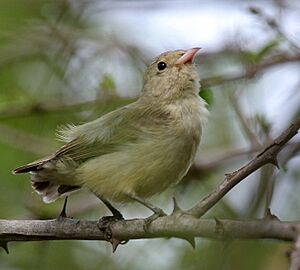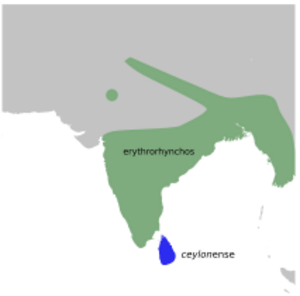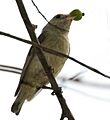Pale-billed flowerpecker facts for kids
Quick facts for kids Pale-billed flowerpecker |
|
|---|---|
 |
|
| Conservation status | |
| Scientific classification | |
| Genus: |
Dicaeum
|
| Species: |
erythrorhynchos
|
 |
|
The pale-billed flowerpecker, also known as Tickell's flowerpecker (Dicaeum erythrorhynchos), is a very small bird. It loves to eat nectar from flowers and juicy berries. You can find this tiny bird in countries like India, Sri Lanka, Bangladesh, and western Myanmar. It's quite common, especially in city gardens where there are lots of berry-filled trees. These birds make a quick, chipping sound, and their unique pinkish, curved beak helps you tell them apart from other birds in the area.
Contents
What Does the Pale-billed Flowerpecker Look Like?
This bird is super tiny, only about 8 centimeters (about 3 inches) long! It's one of the smallest birds you'll see in southern India and Sri Lanka. Its feathers are a plain brownish to olive-green color. Its belly is a buff-olive color, which blends in well with its back. It doesn't have a white belly like the Nilgiri flowerpecker or stripes like the thick-billed flowerpecker. Also, unlike the Nilgiri flowerpecker, it doesn't have any special markings above its eyes.
The pale-billed flowerpecker found in Sri Lanka (called ceylonense) is a bit grayer and smaller than the ones in India. Scientists think these birds might have first come from the Malay Peninsula before spreading to India and nearby areas.
How Does the Pale-billed Flowerpecker Live and Interact with Nature?
In forests, these flowerpeckers often visit plants like Loranthus and Viscum. These plants are special because they grow on other trees, and their seeds are mostly spread by flowerpeckers. The birds usually swallow the berries whole. The seeds pass through their bodies very quickly, in about three to four minutes!
When a seed comes out, it has a sticky coating. The bird then rubs its bottom on a branch to get rid of the seed. This sticky seed then attaches to the branch, where it can start to grow. The pale-billed flowerpecker also helps pollinate the flowers of a plant called Dendrophthoe falcata. When the bird nips the tip of the flower bud, it causes pollen to spray out onto the bird's feathers, which then carries it to other flowers.
In cities, these birds really like fruit trees that have been brought in from other places, like Muntingia calabura (also known as the Singapore cherry). They might swallow the whole fruit or, if it's very ripe, crush it to get to the juicy pulp with their tongues. They also drink nectar from flowers of plants like Sterculia colorata and Woodfordia floribunda, helping these plants make new seeds as they feed.
Reproduction: How Do Pale-billed Flowerpeckers Raise Their Young?
Pale-billed flowerpeckers usually have their babies between February and June. Sometimes, they might have a second group of babies in September. Their nest is like a small, hanging purse. It's made from spiderwebs, plant fibers, moss, and soft down. They hang it from the very tip of a twig high up in a tree. The nest has a small slit for an opening. Inside, the mother bird lays two or three tiny eggs.
Images for kids




